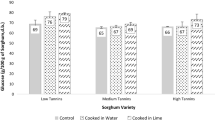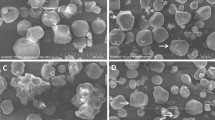Abstract
The application of dry heat to sorghum seeds and meal was not effective in inactivating the amylase inhibitory activity. Overnight soaking followed by heat treatment was more effective in destroying amylase inhibitory activity. Cooking the meal, raw seeds and soaked seeds drastically reduced the levels of α-amylase inhibitory activity.
Similar content being viewed by others
References
Hulse JH, Learning EM, Pearson OE (1980) Sorghum and the Millets: Their composition and nutritive value. New York: Academic Press
Salunke DK, Chauvan JK, Jadhav (1985) Nutritional and processing quality of sorghum. Oxford & IBH Publishing.
Kutty Ambalath, Moiden, Pattabirman TN (1986) Isolation and characterisation of an amylase inhibitor from sorghum seeds specific for human enzymes. J Agric Food Chem 34(4): 552–7.
Granum PE (1979) Studies on α-amylase inhibitors in foods. Food Chem 4: 173–178
Marshall JJ (1975) α-amylase inhibitors from plants. Ac S Symp 15; 244–266
Shivraj B, Pattabiraman TN (1980) Natural plant enzyme inhibitors, Part VIII: Purification and properties of two alpha amylase I from Ragi (Eleusine coracana) grains. Ind J Biochem Biophys 17: 181–185
Chandrasekhar G, Suryaprasad D, Pattabiraman TN (1981). Natural plant enzyme inhibitors: α-amylase inhibitors in millets. J Sci Food Agric 32: 9–16
Bernfeld P (1955) Amylases α and β. In: Methods in Enzymology, vol. 1 Ed. Colowick SP and Kaplan NO. New York: Academic Press, pp. 149–159.
Singh U (1988) Antinutritional factors of chick pea and pigeon pea and their removal by processing. Plant Food Hum Nutr 38: 251
Soretrisno V, Holmes ZA, Mutter LT (1982) Effect of heating time of soybean on vitamin B6, folacin retention, trypsin inhibitor activity and microretention, trypsin inhibitor activity and microstructure changes. J Food Sci 42 (2): 530–4
Hattiarachchy NS, Herath HMW, Wickramanyak X (1978). The nutritional value of winged bean with special reference to five varieties in Sri Lanka. Nutr Food Sci 2: 211–20
Borhade VP, Kadam SS, Salunkhe DK (1984) Solubilization and functional properties of moth bean and horse gram proteins. J Food Biochem 8: 229–235
Kadam SS, Smithard RR (1987) Effect of heat treatment on trypsin inhibitor and hemagglutinating activities in winged bean. (Qual Plant) Plant Foods Hum Nutr 37:151–157
Babar VS, Chauvan JK, Kadam SS (1988). Effects of heat treatments and germination on trypsin inhibitor activity and polyphenols in jack bean. Plant Foods Hum Nutr 38: 319–324
Udupa SL, Prabhakar AR, Tandon S (1989) α-amylase inhibitors in plant foods. Food Chem 34 (2): 95–101
Author information
Authors and Affiliations
Rights and permissions
About this article
Cite this article
Mulimani, V.H., Supriya, D. Effect of heat treatments on alpha-amylase inhibitor activity in sorghum (Sorghum bicolour L.). Plant Food Hum Nutr 44, 181–186 (1993). https://doi.org/10.1007/BF01088383
Received:
Accepted:
Issue Date:
DOI: https://doi.org/10.1007/BF01088383




